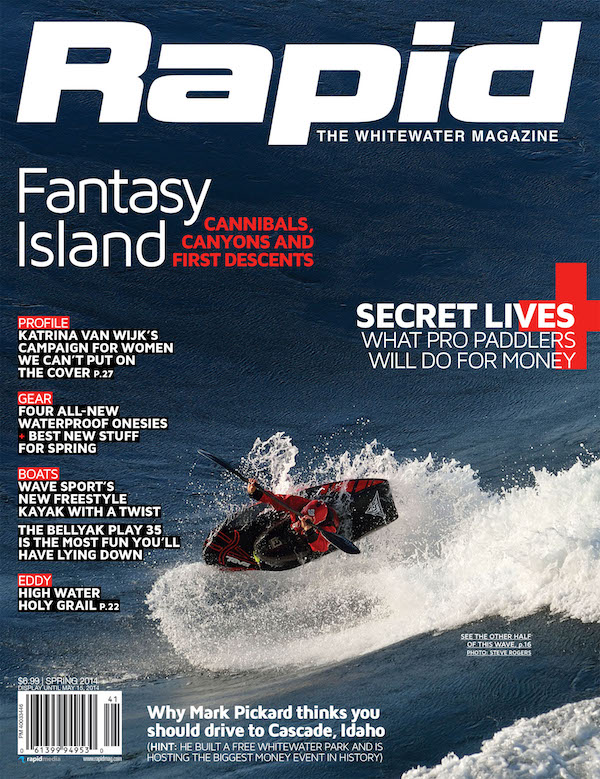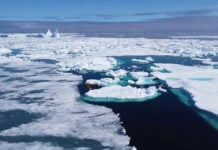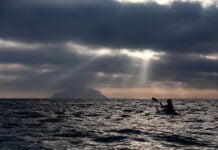Sorcery, sacred canyons, first descents and redemption runs. Four kayakers take on Papua New Guinea’s deadly jungle rivers in this feature, first published in Rapid magazine.
Bounding over rock and moss, ducking beneath low hanging branches, children ran along the riverbank. “White man! White man!” they yelled, pointing at the kayakers as they ran along side them, trying to keep up.
Paddling into the tiny village of Gembogl Station was like entering an arena filled with bewildered spectators. Everyone, from those in the huts and schools high on the steep hillsides, to those along the riverbank, turned to look.
“It was the most people I’d ever paddled in front of,” says Barny Young.
Hamming it up for the unexpected audience, Jordy Searle eyed the town’s log bridge hanging mere feet above the fast-flowing river and, reaching it, rolled to slide his kayak under. Young followed suit. “It was ridiculous. It felt like thousands of people screaming and cheering,” Searle says. “I think they were just stoked to see us survive.”
As the first whitewater paddlers in remote Papua New Guinea (PNG), the entire expedition was a spectacle. With 4,500-meter tall peaks and exceptional rainfall, Papua New Guinea has enough gradient and water to keep a skirt on any kayaker. On an island off the north coast of Australia, PNG is a country untouched by tourists. With a reputation for virgin jungle, deadly wildlife and modern-day cannibalism, it’s a destination for only the heartiest of paddlers.
The first time Barny Young and Jordy Searle took on the wild rivers of PNG was in May 2011, six years after they met on the west coast of New Zealand through a mutual love of paddling and partying. Together they hatched a plan to paddle the unknown rivers of PNG, a country untouched by rafters and kayakers.

Together, with a third team member, Shannon Mast, the group successfully paddled eight rivers in 2011, notching seven first descents, including the Bosu, Koningi and Mai rivers.
After almost a month of successful paddling—overlooking a few bouts of food poisoning—what ended the 2011 trip was a nasty swim. On the Chimbu River, the last of the expedition, Young got caught in a big hydraulic.
“It was one of the scariest swims I’ve ever had,” says Young of the 30-second beatdown. Knowing the river disappeared underground just downstream, he saved himself by grabbing onto a protruding rock on shore. Young had only a few scratches and bruises to show for his misadventure, but his boat was gone, sucked into the undercut he’d narrowly avoided.
After waiting fruitlessly for hours for the boat to be flushed out of the underground cavern, the group found a coffee trail and walked out to the nearest village. They asked that if the boat resurfaced they be contacted and they would pay a reward of 100 kina (equivalent to about $40 USD, or approximately 10 times what the average local worker makes in a day).
A few days later, they received a call that the boat had been found and some kids were running 10 kilometers to town to meet the kayakers and return it and collect their reward.
“It turns out, they’d been swimming under the rock with ropes attached to them to get the boat out,” says Searle. “A lot could have gone very wrong with that.”
For anyone looking for an easy vacation, PNG is not the first choice. It occupies the eastern half of the island of New Guinea, the world’s largest and highest tropical island. Though it’s a basin for bio-diversity, PNG is generally regarded as a high-risk destination for tourists and has been the subject of unsavory press about sorcery killings, cannibalism and high crime rates.
In just 100 years, the people of PNG have fast-forwarded from stone to steel to silicone—it’s a country where many people who have cell phones still cook over fires.
“We wanted to go because no one had been there,” says Searle, adding that the country’s mountainous topography and wet climate promised a great kayaking destination. “At the same time, there’s a huge cultural hurdle to get over. There’s no tourism, no precedent, no system—that’s part of the adventure.”
PNG’s rivers aren’t the toughest on earth, but Young says they have “some of the best whitewater in the world,”—and he’d know. A jet-setting kayaker, he paddled the Stikine four times over the summer of 2013 and is one of the few to paddle all 13 classic High-Sierra runs. “It’s the full-on nature of the country that has stopped people from going,” he says. The difficulty of logistics, combined with the cultural experience and lack of river beta makes PNG rivers undoubtedly epic—a paddling destination like no other.
Rivers are the lifeblood for the remote communities, who use the water for drinking, cooking and cleaning. Even in remote jungle, the group drew crowds to the riverbank everywhere they went.
“People genuinely thought we were going to die,” says Searle. “It was always a good indication that we were coming up to a big rapid when locals started yelling and waving their arms from the riverbank.”

Searle and Young had been warned that PNG was not a place where they could walk around freely. Acquaintances, who flew helicopters for the mining industry, the biggest industry in the country, said that they were picked up at the airport by guards and stayed in barbwire-enclosed compounds they didn’t leave on foot.
At a take-out along the Mai River, a local kid explained that several weeks prior the bodies of two women who had been drowned for practicing witchcraft had washed into that very eddy.
According to the United Nations, sorcery-related killings in PNG have been on the rise. The grisly murders gained worldwide attention last year when a 20-year-old mother was burned alive in front of hundreds of onlookers.
“A lot of bad stuff does happen in PNG,” admits Searle. “But I have this idea that people are inherently good and you just have to find that common ground.”
By randomly messaging people in PNG on Facebook prior to their first trip, Searle and Young were able to hook up with some well-connected locals who set them up with reliable drivers and safe accommodation once in-country.
The 2023 return trip to PNG had one specific goal: The Chimbu. “It was unfinished business,” says Young. “The Chimbu was the river that beat us and that’s why we were so keen to get back.”
Its class V waters are in the heart of the country’s rugged highland region where the river carves its way from the base of Mount Wilhelm (4,500 meters) through 100-meter deep gorges to the mighty Wahgi River below. Getting there meant two days of bouncing around in the back of a pickup.
The aim of the trip was to travel a rough dirt road that paralleled the river to its highest navigable source, then negotiate the challenging rapids and canyons of the Chimbu to the town of Kundiawa, 50 kilometers distant.

Aided by a Sport New Zealand grant, awarded to Kiwis pushing the boundaries of sport, and with the contacts garnered from the first trip, Young and Searle were also accompanied by two new Kiwi trip mates, Ari Walker and Matt Coles.
On a hot and humid April morning, the group put in a kilometer below the source lake of the Chimbu. It took them most of the day to get to Gembogl Station four kilometers away, paddling burly waves and perfecting their limbo technique under low-hanging bamboo branches. It was there they were greeted by the highland’s version of a stadium audience.
They spent the night in the Gembogl Station Resource Centre for Orphans, a home for children whose parents had died of HIV/AIDS. The next morning the group followed the sound of singing to the local elementary school. After the song finished, the teacher translated as hundreds of kids and adults gathered around in the steamy morning air to listen to the paddlers’ stories.
“We told them how lucky they were to live in such a pristine environment and why it’s important to take care of it for future generations.”
“We told them how lucky they were to live in such a pristine environment and why it’s important to take care of it for future generations,” says Young. As for the 100-child game of Duck, Duck, Goose that came next, “that’s just Barny, random shit turns up,” says Searle, laughing.
The group approached the crux of their route two days later. Home to a series of increasingly difficult rapids, Sikewage Gorge was the site of Young’s trip-ending swim in 2011.
It’s a sacred site to locals, and it’s easy to see why. Cascading water, class V rapids and mist reflecting in beams of light give the gorge a surreal and mystical feel. They spent the day battling its monster holes and ferocious waves, dwarfed by the 100-meter rock walls on either side.
Nearing the final destination of Kundiawa, the gorge receded and the river slowed. Two young boys came to the river’s edge, running to keep pace with the kayaks. Young and Searle knew they’d succeeded when they reached a crowded riverbank. The people began to cheer, stunned to see the group emerge from the walls of the dark Chimbu canyon—a first descent through the last frontier of Papua New Guinea.
For more whitewater adventures, check out the group’s blog at www.gradientandwater.blogspot.com











